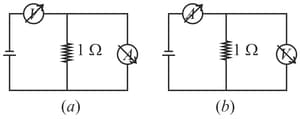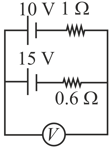MEDIUM
Earn 100
Why a high-value resistor is used in series with a galvanometer in order to convert it into a voltmeter?
Important Questions on Magnetic Effect of Current
EASY
In a moving coil galvanometer, when the number of turns of the coil is doubled,
EASY
The number of turns in a coil of Galvanometer is tripled, then
EASY
The sensitivity of tangent galvanometer is increased, if
MEDIUM
A galvanometer of resistance giving full scale deflection for a current of milliampere is to be changed into a voltmeter of range .
A resistance of _____ has to be connected in series with the galvanometer.
MEDIUM
A galvanometer, whose resistance is , has divisions in it. When a current of A passes through it, its needle (pointer) deflects by one division. To use this galvanometer as a voltmeter of range it should be connected to a resistance of:
MEDIUM
A moving coil galvanometer has resistance and it indicates full deflection at current. A voltmeter is made using this galvanometer and a resistance. The maximum voltage, that can be measured using this voltmeter, will be close to:
HARD
A student uses the resistance of a known resistor ( ) to calibrate a voltmeter and an ammeter using the circuits shown below. The student measures the ratio of the voltage to current to be in circuit
(a) and in circuit (b). From these measurements, the resistance (in ) of the voltmeter and ammeter are found to be close to

EASY
A galvanometer acting as a voltmeter will have
EASY
, and are voltmeters of resistance , and respectively as shown in the figure. When some potential difference is applied between and , the voltmeter readings are and respectively. Then:

MEDIUM
A moving coil galvanometer allows a full scale current of . A series resistance of is required to convert the galvanometer into a voltmeter of range . Therefore, the value of shunt resistance required to convert the above galvanometer into an ammeter of range is:
MEDIUM
A galvanometer can work as a voltmeter by connecting
HARD
Two identical moving coil galvanometer have resistance and full scale deflection at current. One of them is converted into a voltmeter of full scale reading and the other into an Ammeter of full scale current using appropriate resistors. These are then used to measure the voltage and current in the Ohm's law experiment with resistor by using an ideal cell. Which of the following statement(s) is/are correct?
EASY
A galvanometer coil has a resistance of and the meter shows full scale deflection for a current of What resistance needs to be connected to convert the meter into a voltmeter of range to
EASY
A battery with internal resistance and a battery with internal resistance are connected in parallel to a voltmeter (see figure). The reading in the voltmeter will be close to:

MEDIUM
For full scale deflection of total divisions, voltage is required in galvanometer. The resistance of galvanometer if its current sensitivity is will be:
MEDIUM
How can a moving coil galvanometer be converted into a voltmeter?
EASY
How will you convert a moving coil galvanometer into voltmeter?
HARD
A galvanometer having a coil resistance gives a full scale deflection when a current of is passed through it. What is the value of the resistance which can convert this galvanometer into a voltmeter given full scale deflection for a potential difference of
HARD
A galvanometer of resistance has divisions on its scale and has sensitivity of . It is to be converted to voltmeter with three ranges, of and The appropriate circuit to do so is:
EASY
When a current of is passed through a galvanometer having a coil of resistance , it shows full-scale deflection. The value of the resistance to be put in series with the galvanometer to convert it into a voltmeter of range is:

